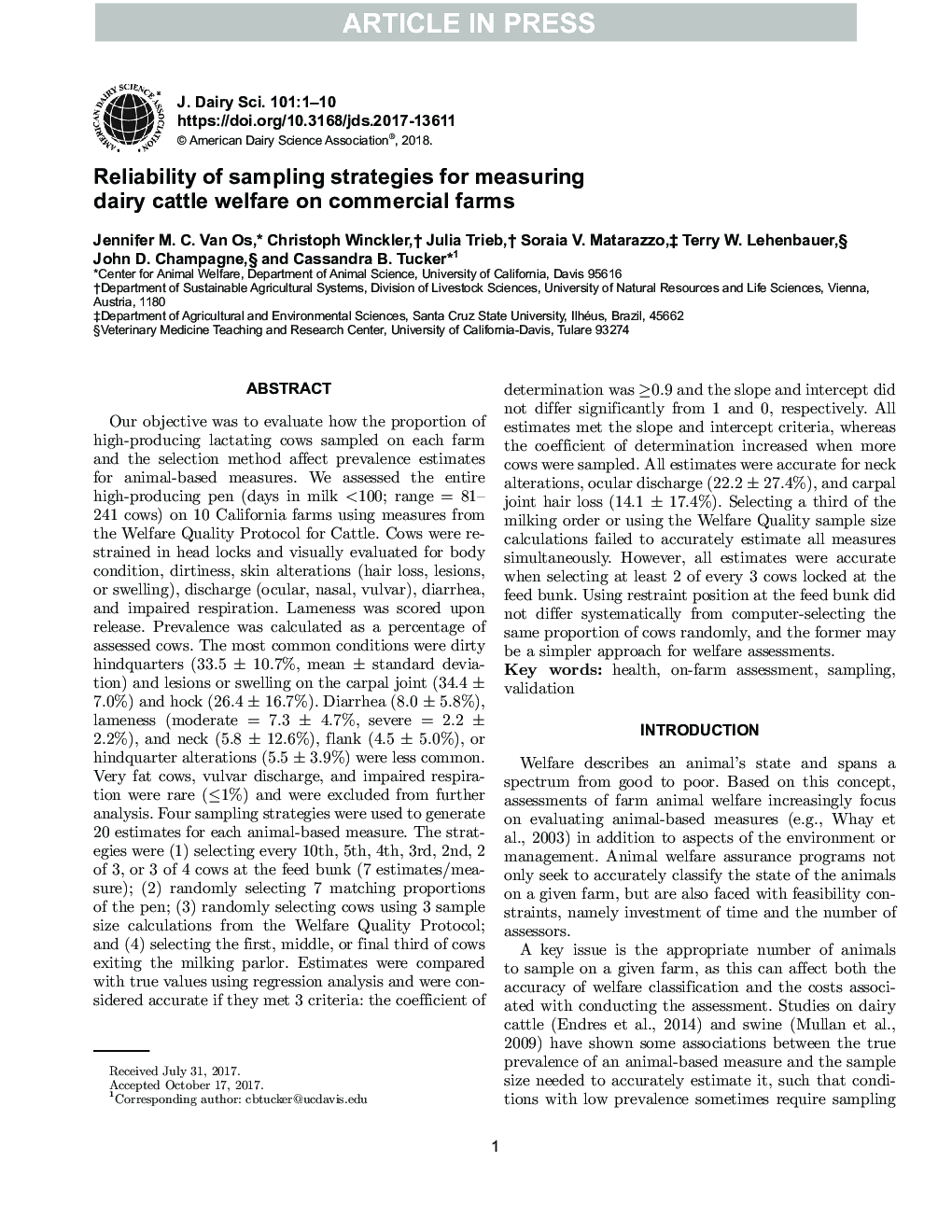| کد مقاله | کد نشریه | سال انتشار | مقاله انگلیسی | نسخه تمام متن |
|---|---|---|---|---|
| 8501677 | 1553843 | 2018 | 10 صفحه PDF | دانلود رایگان |
عنوان انگلیسی مقاله ISI
Reliability of sampling strategies for measuring dairy cattle welfare on commercial farms
ترجمه فارسی عنوان
پایایی استراتژی های نمونه گیری برای اندازه گیری رفاه گاوهای شیری در مزارع تجاری
دانلود مقاله + سفارش ترجمه
دانلود مقاله ISI انگلیسی
رایگان برای ایرانیان
کلمات کلیدی
سلامتی، ارزیابی در مزرعه، نمونه برداری، اعتبار سنجی،
موضوعات مرتبط
علوم زیستی و بیوفناوری
علوم کشاورزی و بیولوژیک
علوم دامی و جانورشناسی
چکیده انگلیسی
Our objective was to evaluate how the proportion of high-producing lactating cows sampled on each farm and the selection method affect prevalence estimates for animal-based measures. We assessed the entire high-producing pen (days in milk <100; range = 81-241 cows) on 10 California farms using measures from the Welfare Quality Protocol for Cattle. Cows were restrained in head locks and visually evaluated for body condition, dirtiness, skin alterations (hair loss, lesions, or swelling), discharge (ocular, nasal, vulvar), diarrhea, and impaired respiration. Lameness was scored upon release. Prevalence was calculated as a percentage of assessed cows. The most common conditions were dirty hindquarters (33.5 ± 10.7%, mean ± standard deviation) and lesions or swelling on the carpal joint (34.4 ± 7.0%) and hock (26.4 ± 16.7%). Diarrhea (8.0 ± 5.8%), lameness (moderate = 7.3 ± 4.7%, severe = 2.2 ± 2.2%), and neck (5.8 ± 12.6%), flank (4.5 ± 5.0%), or hindquarter alterations (5.5 ± 3.9%) were less common. Very fat cows, vulvar discharge, and impaired respiration were rare (â¤1%) and were excluded from further analysis. Four sampling strategies were used to generate 20 estimates for each animal-based measure. The strategies were (1) selecting every 10th, 5th, 4th, 3rd, 2nd, 2 of 3, or 3 of 4 cows at the feed bunk (7 estimates/measure); (2) randomly selecting 7 matching proportions of the pen; (3) randomly selecting cows using 3 sample size calculations from the Welfare Quality Protocol; and (4) selecting the first, middle, or final third of cows exiting the milking parlor. Estimates were compared with true values using regression analysis and were considered accurate if they met 3 criteria: the coefficient of determination was â¥0.9 and the slope and intercept did not differ significantly from 1 and 0, respectively. All estimates met the slope and intercept criteria, whereas the coefficient of determination increased when more cows were sampled. All estimates were accurate for neck alterations, ocular discharge (22.2 ± 27.4%), and carpal joint hair loss (14.1 ± 17.4%). Selecting a third of the milking order or using the Welfare Quality sample size calculations failed to accurately estimate all measures simultaneously. However, all estimates were accurate when selecting at least 2 of every 3 cows locked at the feed bunk. Using restraint position at the feed bunk did not differ systematically from computer-selecting the same proportion of cows randomly, and the former may be a simpler approach for welfare assessments.
ناشر
Database: Elsevier - ScienceDirect (ساینس دایرکت)
Journal: Journal of Dairy Science - Volume 101, Issue 2, February 2018, Pages 1495-1504
Journal: Journal of Dairy Science - Volume 101, Issue 2, February 2018, Pages 1495-1504
نویسندگان
Jennifer M.C. Van Os, Christoph Winckler, Julia Trieb, Soraia V. Matarazzo, Terry W. Lehenbauer, John D. Champagne, Cassandra B. Tucker,
